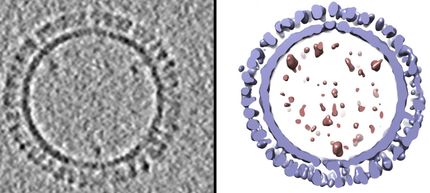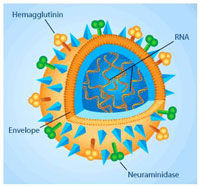Tobacco plants yield the first vaccine for the dreaded 'cruise ship virus'
Scientists have used a new vaccine production technology to develop a vaccine for norovirus. Sometimes called the "cruise ship virus," this microbe can spread like wildfire through passenger liners, schools, offices and military bases. The new vaccine is unique in its origin — it was "manufactured" in a tobacco plant using an engineered plant virus. Researchers are enlisting plants in the battle against norovirus, swine flu, bird flu, and other leading infectious diseases. This plant biotechnology opens the door to more efficient, inexpensive ways to bring vaccines quickly to the public, especially critical in times when viruses mutate into unpredictable new strains, said Charles Arntzen, Ph.D., who reported on the topic at the 238th National Meeting of the American Chemical Society (ACS).
"The recent outbreak of H1N1 influenza virus has once again reminded us of the ability of disease-causing agents to mutate into new and dangerous forms," Arntzen points out. "It will be at least six months until a vaccine for this new strain will be available, and it will take even longer to create large stock piles of vaccine. For a case like the H1N1 influenza virus, you want to be able to move very rapidly and introduce a commercial vaccine in the shortest possible time. We think we have a major advantage in using engineered plant viruses to scale-up vaccine manufacture within weeks instead of months."
Noroviruses are always mutating, making it a moving target for vaccine developers. Arntzen says this has presented an obstacle for big pharmaceutical companies who might have considered developing a vaccine. Production costs can skyrocket when a single disease may frequently require new vaccines that must be developed and tested for safety and effectiveness. As a result, vaccines do not exist for many diseases that sicken enormous numbers of people each year. Arntzen notes that plant biotechnology could create a cheaper, quicker vaccine manufacturing technique uniquely suited to combat mutating viruses like norovirus and the flu.
Norovirus will continue to evolve new strains, so Arntzen's team designed a vaccine manufacturing process quick enough to keep up with it and other shape-shifting viruses.
"With plant-based vaccines, we can generate the first gram quantities of the drug and do clinical tests within eight to 10 weeks… We could easily scale that up for commercial use in a two to four month period," explains Arntzen.
Plant-based vaccine production also offers cost advantages. Building greenhouses is more cost effective than the sterilized facilities, expensive manufacturing technology and stainless steel tanks required for the insect or mammalian cell cultures used in most traditional vaccines.
"The other cost advantages relate to vaccine purification and formulation. Purification from plant extracts is simpler because there are no infectious agents to clean up. There are no viruses in plants which can infect humans, so you don't have to worry about viral removal," notes Arntzen.
The team re-engineered plant viruses to produce high levels of specially designed "virus-like" nanoparticles in tobacco plants. At about 25 nanometers in diameter, the particles are about the same size as the norovirus, but they consist only of the outer surface protein — the portion of the virus recognized by the human immune system. The particles contain none of the infectious material of the original virus, but they stimulate a robust immune response to fight off an actual infection.
Topics
Organizations
Other news from the department science
These products might interest you

Eclipse by Wyatt Technology
FFF-MALS system for separation and characterization of macromolecules and nanoparticles
The latest and most innovative FFF system designed for highest usability, robustness and data quality

DynaPro Plate Reader III by Wyatt Technology
Screening of biopharmaceuticals and proteins with high-throughput dynamic light scattering (DLS)
Efficiently characterize your sample quality and stability from lead discovery to quality control

Get the life science industry in your inbox
By submitting this form you agree that LUMITOS AG will send you the newsletter(s) selected above by email. Your data will not be passed on to third parties. Your data will be stored and processed in accordance with our data protection regulations. LUMITOS may contact you by email for the purpose of advertising or market and opinion surveys. You can revoke your consent at any time without giving reasons to LUMITOS AG, Ernst-Augustin-Str. 2, 12489 Berlin, Germany or by e-mail at revoke@lumitos.com with effect for the future. In addition, each email contains a link to unsubscribe from the corresponding newsletter.



















































